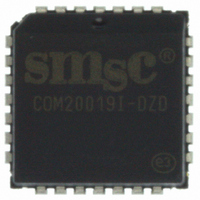COM20019I-DZD SMSC, COM20019I-DZD Datasheet - Page 42

COM20019I-DZD
Manufacturer Part Number
COM20019I-DZD
Description
IC CTRLR ARCNET 2KX8 RAM 28-PLCC
Manufacturer
SMSC
Series
ARCNETr
Datasheet
1.COM20019I-DZD.pdf
(65 pages)
Specifications of COM20019I-DZD
Controller Type
ARCNET Controller
Interface
Differential
Voltage - Supply
4.5 V ~ 5.5 V
Current - Supply
20mA
Operating Temperature
0°C ~ 70°C
Mounting Type
Surface Mount
Package / Case
28-PLCC
Lead Free Status / RoHS Status
Lead free / RoHS Compliant
Other names
638-1000-5
Available stocks
Company
Part Number
Manufacturer
Quantity
Price
Company:
Part Number:
COM20019I-DZD
Manufacturer:
SMSC
Quantity:
1 028
Company:
Part Number:
COM20019I-DZD
Manufacturer:
Microchip Technology
Quantity:
10 000
Company:
Part Number:
COM20019I-DZD-TR
Manufacturer:
Microchip Technology
Quantity:
10 000
6.8
Rev. 09-25-07
registers may be written to. Since writing a non-zero value to the Node ID Register wakes up the core, the
Setup1 Register should be written to before the Node ID Register. Until a non-zero value is placed into the
NID Register, no microcode is executed, no tokens are passed by this node, and no reconfigurations are
generated by this node. Once a non-zero value is placed in the register, the core wakes up, but the node
will not attempt to join the network until the TX Enable bit of the Configuration Register is set.
Before setting the TX Enable bit, the software may make some determinations. The software may first
observe the Receive Activity and the Token Seen bits of the Diagnostic Status Register to verify the health
of the receiver and the network.
Next, the uniqueness of the Node ID value placed in the Node ID Register is determined. The TX Enable
bit should still be a logic "0" until it is ensured that the Node ID is unique. If this node ID already exists, the
Duplicate ID bit of the Diagnostic Status Register is set after a maximum of 6.72S (or 13.44S if the ET1
and ET2 bits are other than 1,1). To determine if another node on the network already has this ID, the
COM20019I compares the value in the Node ID Register with the DID's of the token, and determines
whether there is a response to it. Once the Diagnostic Status Register is read, the DUPID bit is cleared.
The user may then attempt a new ID value, wait 6.72S before checking the Duplicate ID bit, and repeat the
process until a unique Node ID is found. At this point, the TX Enable bit may be set to allow the node to
join the network. Once the node joins the network, a reconfiguration occurs, as usual, thus setting the
MYRECON bit of the Diagnostic Status Register.
The Tentative ID Register may be used to build a network map of all the nodes on the network, even once
the COM20019I has joined the network.
COM20019I looks for a response to a token whose DID matches the Tentative ID Register. The software
can record this information and continue placing Tentative ID values into the register to continue building
the network map. A complete network map is only valid until nodes are added to or deleted from the
network. Note that a node cannot detect the existence of the next logical node on the network when using
the Tentative ID. To determine the next logical node, the software should read the Next ID Register.
IMPROVED DIAGNOSTICS
The COM20019I allows the user to better manage the operation of the network through the use of the
internal Diagnostic Status Register.
A high level on the My Reconfiguration (MYRECON) bit indicates that the Token Reception Timer of this
node expired, causing a reconfiguration by this node. After the Reconfiguration (RECON) bit of the Status
Register interrupts the microcontroller, the interrupt service routine will typically read the MYRECON bit of
the Diagnostic Status Register.
Successive occurrences of a logic "1" on the MYRECON bit indicates that a problem exists with this node.
At that point, the transmitter should be disabled so that the entire network is not held down while the node
is being evaluated.
The Duplicate ID (DUPID) bit is used before the node joins the network to ensure that another node with
the same ID does not exist on the network. Once it is determined that the ID in the Node ID Register is
unique, the software should write a logic "1" to bit 5 of the Configuration Register to enable the basic
transmit function. This allows the node to join the network.
The Receive Activity (RCVACT) bit of the Diagnostic Status Register will be set to a logic "1" whenever
activity (logic "1") is detected on the RXIN pin.
The Token Seen (TOKEN) bit is set to a logic "1" whenever any token has been seen on the network
(except those tokens transmitted by this node).
The RCVACT and TOKEN bits may help the user to troubleshoot the network or the node. If unusual
events are occurring on the network, the user may find it valuable to use the TXEN bit of the Configuration
Register to qualify events. Different combinations of the RCVACT, TOKEN, and TXEN bits, as shown
indicate different situations:
DATASHEET
Reading the Diagnostic Status Register resets the MYRECON bit.
Page 42
Once a value is placed in the Tentative ID Register, the
Cost Competitive ARCNET (ANSI 878.1) Controller with 2K x 8 On-Chip RAM
SMSC COM20019I













